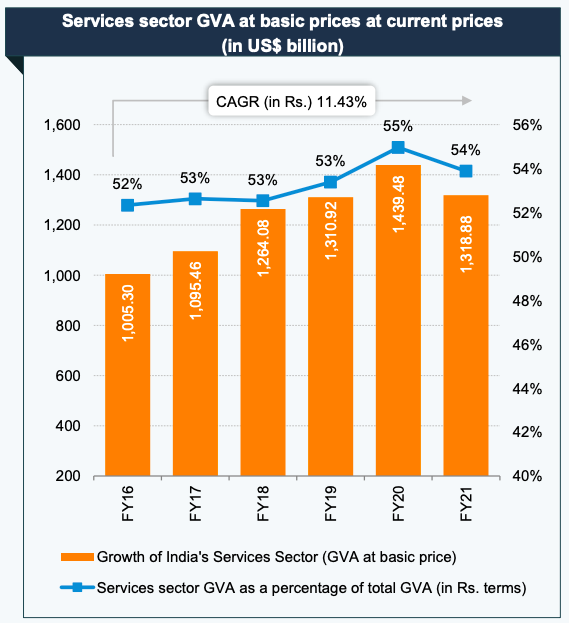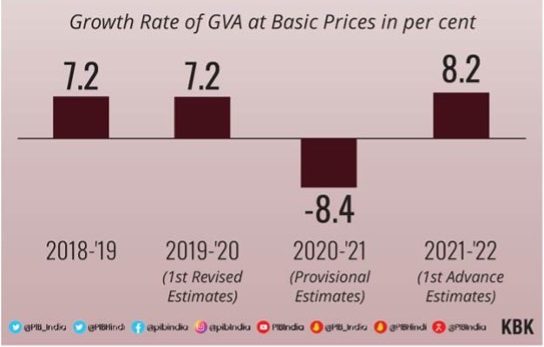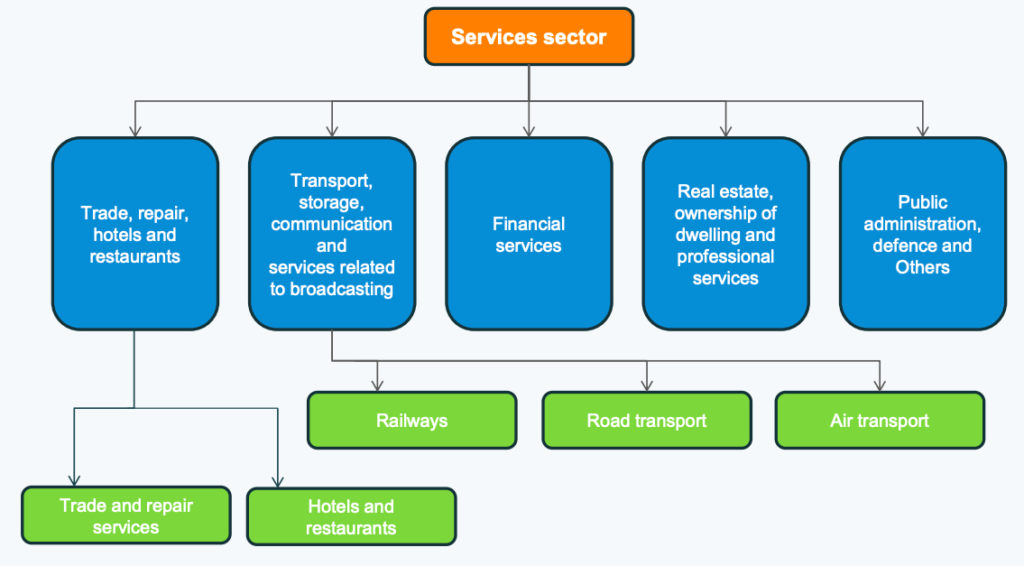ForumIAS announcing GS Foundation Program for UPSC CSE 2025-26 from 19 April. Click Here for more information.
Contents
| For 7PM Editorial Archives click HERE → |
Introduction
The services sector is the most dominant sector of Indian economy in terms of the GDP. It has also attracted significant foreign investment, and is major contributor to India’s exports. It also provides employment to ~30% of India’s workforce. Services sector in India covers a wide variety of activities such as trade, hotel and restaurants, transport, storage and communication, financing, insurance, real estate, business services, community, social and personal services, and services associated with construction. Services Sector is poised to play a vital role in achieving the goals of US$ 5 trillion economy in the medium term and a developed economy status in the long term.
What is the importance of Services Sector to India’s Economy?
Contribution in GVA: The services sector of India remains the engine of growth for India’s economy and contributed 53% to India’s Gross Value Added at current prices in FY21-22.
Source: IBEF
The sector has consistently grown at the annual rate of ~7% in the last few year (barring 2020-21 due to pandemic).
Source: mygov.in
Overall, the Services Sector grew by 10.8% Year on Year (YoY) in first half (H1) 2021-22.The overall Services sector GVA is expected to grow by 8.2 per cent in 2021-22,
Contribution to Exports: According to the WTO, India’s services export market share improved from 3% in 2010 to 3.5% in 2019 and 4% in 2020 and 2021. Despite the impact of COVID-19, there was an increase of ~25% in net exports of services in 2021-22. The Government has set a target of services export of US$ 350 billion in FY2022-23, 37% higher than ~US$ 255 billion exports in 2021-22.
Helpful in FDI inflows: The Services Sector in India was the largest recipient of FDI inflows worth US$ 94.19 billion between April 2000-March 2022. The services category ranked 1st in FDI inflow as per data released by the Department for Promotion of Industry and Internal Trade (DPIIT).
Contribution in Start-ups and Patents: Start-ups in India have grown remarkably over the last six years, most of which belonged to Services Sector. More than 61,400 start-ups have been recognized in India as of January 2022.
Source: IBEF. Sub-sectors of Services Sector in India
What are the future prospects of the Services Sector in India?
Upcoming sectors are expected to contribute to rapid expansion of services sector in India: (a) By 2025, healthcare industry is expected to reach US$ 372 billion; (b) India’s digital economy is estimated to reach US$ 1 trillion by 2025; (c) By end of 2023, India’s IT and business services sector is expected to reach US$ 14.3 billion with 8% growth; (d) Artificial Intelligence (AI) is expected to boost India’s annual growth rate by 1.3% by2035, according to a discussion paper by Niti Aayog
The implementation of the Goods and Services Tax (GST) has created a common national market and reduced the overall tax burden on goods. It is expected to reduce costs in the long run-on account of availability of GST input credit, which will result in the reduction in prices of services. India’s software service industry is expected to reach US$ 1 trillion by 2030.
What factors have contributed to growth of Services Sector in India?
Rise in demand: The service sector bloomed when businesses were outsourced from foreign countries (especially the developed countries) to India for communication, advertisement, computer service, and banking. Because of this high demand, there was high growth in the service sector. Rise in domestic population increased demand for services. The necessity for basic services like hospitals, educational institutions, post and telegraph services, police stations, courts, transportation and banking services have increased with increase in population.
Technology and Structural Changes: The Indian economy has undergone several technological and structural changes. It comprises a change in economic reliance from primary to tertiary industries. Technical advancements have also led in a shift in outsourcing, leading in the expansion of the service industry. Technology also aided growth in primary and secondary sectors. The development in agriculture and industrial sector has increased the need of services such as transportation, storage and trade.
Economic Reforms in 1991: The growth in the service sector in India has been linked to the reforms of the 1990s. The service sector started to grow in the mid-1980s, but growth accelerated after the economic reforms in 1991. Reforms in the service sector led to privatisation, the removal of FDI restrictions, and streamlining of approval procedures among others. With economic growth and the rise in per capita income, demand changed from necessary to discretionary consumption and propelled the growth of services. Elasticity of demand for services at high incomes has contributed to the growth of the sector. As per income of the people increased the demand for services like tourism, retailing, catering and elite education also increased.
Attractive ecosystem: The Government’s move to launch ‘Start-up India’ aims to create an inclusive ecosystem for entrepreneurs and push for innovation. Services are a big part of this system. The technology infrastructure required for such an ecosystem has increased the potential for the sector in India. Low setup cost make this sector an attractive investment destination. India also has a reasonably well-developed financial market.
Skilled Manpower: A large pool of skilled IT manpower has made India into a global outsourcing hub. It now commands a 55% share in the global sourcing market.
Improved Productivity: An other factor behind development of service sector is increase in productivity of labour. Due to better technology and improved labour productivity there is a increase in output of manufacturing goods and agriculture with less labour.
Global Technology Hub: India is the digital capabilities hub of the world, with the presence of 75% of global digital talent. In the next five years, the Ministry of Electronics and Information Technology is working to increase the contribution of the digital economy to 20% of GDP The government is working to build cloud-based infrastructure for collaborative networks that can be used for the creation of innovative solutions by entrepreneurs and startups. In the past five years (until July 2021),India filed >4000 artificial intelligence (Al) patents.
What are the challenges faced by the Services Sector in India?
Lack of Government Incentives: Many experts feel that Government have not provided incentives to the services sector on the same lines as the manufacturing sector e.g., under the export promotion scheme for manufacturing, MEIS (Merchandise Exports Incentive Scheme), merchandise exporters benefited to the extent of over INR 40,000 crore in 2018-19. The corresponding benefit for service exporters under SEIS (Services Exports Incentive Scheme) was ~INR 4,000 (10% of merchandise exporters).
Similarly, the Government provides incentives like tax exemptions for green-field manufacturing projects. Such incentives are missing for creating infrastructure for services sectors like tourism, building of hotels, hospitals and universities etc. There is lack of PLI schemes for services sector.
Trade Restrictions: Services sector is hampered by restrictions placed by foreign governments like restrictions on movement of service professionals, domestic certification requirements for foreign service providers tax on offshore income of Indian service firms etc. These restrictions limit the export potential of India’s Services Sector. Similarly, India also performs poorly on OECD’s Services Trade Restrictiveness Index (STRI) e.g., out of 50 sample countries, only Thailand and Indonesia were more restrictive than India.
Skilled Manpower: While there is a large pool of talented professional, it is not enough to support the growth of the sector. Industry experts lament that many graduates lack employable skills and considerable effort is required to train them.
Infrastructure: Lack of infrastructure (like transportation, connectivity, communication) limit the potential of services sectors like tourism and hospitality etc.
Access to Finance: Many small services firms lack access to affordable finance to scale up their operations. Lack of finance hampers access to technology, up-skilling of people, up-gradation of systems and processes that impacts their competitiveness.
How can the challenges be addressed?
First, the Services Sector in India requires structured policy interventions by the Government. The Government should launch a ‘Services from India’ initiative on the lines of Make in India. Government should consider greater tax incentives, and PLI like scheme for Services Sector to support an increase in services exports.
Second, Services need to be accorded a greater priority in trade negotiations. Focus of India’s FTAs has been on merchandise trade. Although the trend is changing, the India-Australia ECTA has several measures to facilitate India’s service exports (like mutual recognition of professional services, avoiding double taxation on offshore income of Indian service firms in Australia etc.). This should be ensured in India’s upcoming FTAs.
Third, India should also push for setting standards for global data governance. Resolving data and privacy barriers will provide a big impetus to outsourcing of consultation services. India’s services sector can be the biggest beneficiary.
Fourth, IT Sector contributes ~55% of total services sector. The Government should make a comprehensive roadmap for further diversification of the services sector. Sub-Sectors like Healthcare, Tourism (including medical tourism), Banking/Financial Services, Telecommunication need to be supported for further expansion.
Conclusion
The service sector is India’s largest and fastest expanding industry. It has the highest labour productivity and is expected to increase rapidly in the future. The proportion of services in overall commerce in India is greater than the worldwide average. By increasing investment, creating jobs and human capital, and improving infrastructure, the service sector will be able to contribute to inclusive growth. It is critical for a developing country like India, which has a huge, young population, to create quality jobs and climb up the value chain. The Government must provide a stable and transparent policy environment along with incentives on the lines of manufacturing sector to further enhance the contribution of services sector in India.
Syllabus: GS III, Indian Economy and issues related to growth and development,
Source: Indian Express, Mint, The Hindu, IBEF







